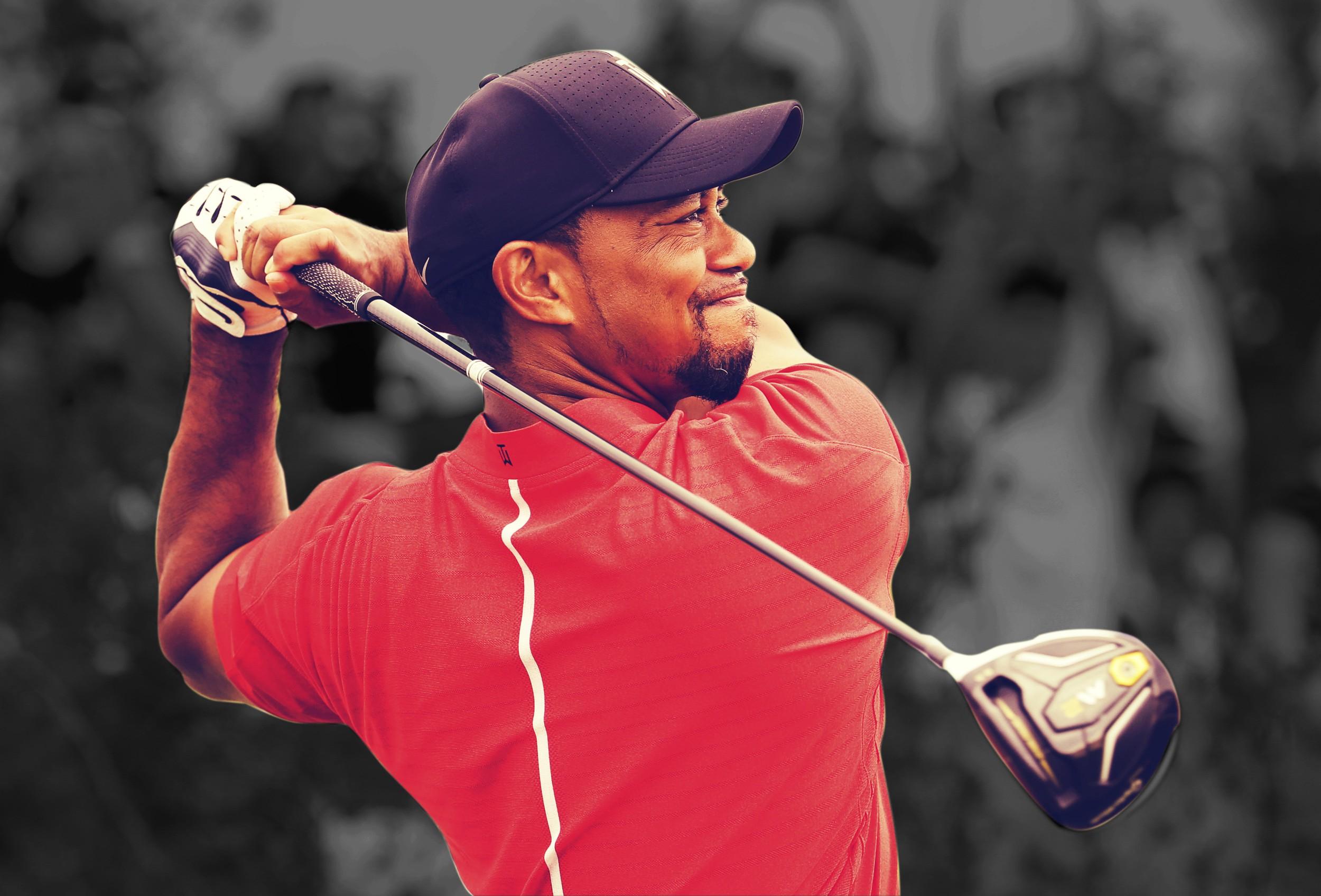Back on the Prowl
The confines were friendly, and he didn’t finish strong, but Tiger Woods’s return after a 15-month absence was still a hopeful, joyful sight
During the Hero World Challenge in the Bahamas, the TV cameras kept returning to one of two subjects: megayachts bobbing in a sparkling harbor (the closest thing the Albany Golf & Beach Resort has to city skyline footage), and Tiger Woods. Last week, after a 15-month absence from professional golf, after multiple back surgeries and recent head fakes, Woods finally, actually teed off in competition once more. And he picked a pretty good time and place to make his return.
This wasn’t a tournament where every Woods tee shot was accompanied by a drunk skunk yelling “YOU DA MAN, TIGER!” — even if, more than once over the past few days, that sentiment and delivery would have been appropriate. Instead, despite having a name that evokes e-sports or one of those triathlons where people Army-crawl through pits of snakes, the Hero World Challenge was defined by chill vibes and grassy sand and froufrou fans gasping and wearing slim, knee-length shorts.
The weather was mostly calm and clear; the course, designed by Ernie Els, has been known to elicit low scores, like a clothes brand with vanity sizing. (Last year, Bubba Watson shot 25 under par to win the tournament; Patrick Reed finished second at 22-under.) Woods wasn’t only competing, he was also hosting. Launched in 1999, the annual tournament benefits his foundation, and he has won it five times. It was an exceptionally friendly setting for an uncertain comeback attempt.
Seven weeks ago, Woods issued a vague, peppy press release announcing the launch of his new personal brand, TGR, to encompass his ventures ranging from golf course design to his foundation to his Florida restaurant called the Woods to his golf game. He wrote that he was “work[ing] toward returning to the sport I love,” but only a week earlier he had abruptly withdrawn from what was supposed to be a comeback tournament in Napa Valley. His letter went on to say that Woods was “taking the next step in what I like to call Chapter 2: my evolution as a competitor off the course.” It felt like a retirement announcement.
But Woods wasn’t BSing with the first part of the statement, as it turned out, and in early November he announced that the comeback would come back. And his presence in the Bahamas was of immediate interest. On Wednesday, playing with wealthy civilians during the pre-tournament pro-am exhibition round, Woods caused a stir with two eagles on the front nine. On Friday, during the tournament’s second round, he finished with a seven-birdie, zero-bogey 65. (Due to Justin Rose’s injury withdrawal Tiger played that round solo, which seemed oddly fitting.) On Saturday morning, he birdied the fifth hole from a sand trap, and the small, polite gallery got as close to rowdy as it ever would.
“The game of golf,” Woods remarked on Saturday afternoon after finishing his round, “is about limiting your mistakes. How bad is your bad? Everyone’s good if they play good.”
For much of the four-day tournament, Woods was good. He recorded more birdies (24) than anyone else competing — a big-name, by-invitation group that included Dustin Johnson, Jordan Spieth, Rickie Fowler, Henrik Stenson, and eventual tournament winner Hideki Matsuyama. He holed long putts and got creative and came close to a hole in one and happily rubbed his caddy’s bald head. He saved par and pumped his fist so demonstratively that the rest of his body had no choice but to get in on the action. (The leg kick made him look like a pitcher on the mound.)
Even as rational minds reminded viewers that the aggressively benign setting was probably providing a boost — Sports Illustrated’s Alan Shipnuck tried to do so as gently as possible — Woods’s performance drew both the reluctant and the enthusiastic right back in. Tiger Tracker, a Twitter account run by a Golf Channel writer who chronicles Woods’s every move with a mix of obsession and woe, gained some 15,000 new followers in the tournament’s first few days. Genuine, consistent current-day golf stars like Fowler and Johnson seemed like sidekicks. Woods teeing off on Sunday in that red shirt, at eight under par — it was comforting, and exciting, and familiar. And despite disappointing in the final round and finishing 15th in a 17-man field, Woods’s return felt mostly like a success. It was a new beginning; it was occasionally just like old times.
Once upon a time it appeared likely that Woods would break Jack Nicklaus’s record of 18 majors. Instead he’s been stuck at 14 since 2008, the year he had to have knee surgery twice. His affairs, aired extremely publicly, destroyed his marriage to Elin Nordegren, his image, and, it appeared, his career. Still, Woods won several tournaments in 2013, finished fourth at the Masters, and regained the no. 1 world ranking for months. But it wouldn’t last. In April 2014 he needed back surgery. Then he kept missing cuts. He looked awful. In September 2015 he needed back surgery again. (On Sunday afternoon, he looked back on this period as “some pretty dire times.”)
“My health is good and I feel strong,” Woods said this October when he withdrew from Napa’s Safeway Open at the last minute, “but my game is vulnerable and not where it needs to be.” He realized his body wasn’t ready for the grueling nature of a full 72-hole tournament. Woods said that part of his training a decade ago involved, in addition to playing golf, running some 30 miles a week. This fall, the goal was simpler: to walk the course a lot more during practice, and take fewer carts. “It’s weird to say,” he explained before the tournament, “but I have to get my walking legs.”
As the wind began to pick up on Saturday afternoon and on Sunday, Woods’s performance died down. He still had his good — he birdied three holes in a row on Sunday — but the bad began to take over, the mistakes refusing to be limited. Twice he double-bogeyed on a par five. He just missed the big putts that, a day or two before, he had made. (On the third hole, he looked ready to strike the pitcher-on-a-mound pose again, but the ball wouldn’t cooperate.) His game grew increasingly unpolished, with mere-mortal shots and loud self admonishments. He faded from contention and finished with a four-over-par round of 76.
Matsuyama, who won the tournament, is a 24-year-old rising star who finished the year on a remarkable hot streak: According to the Golf Channel, he’s shot a cumulative 89 under par in his 20 most recent rounds. And yet his win, and the great scores from players like the 40-year-old Stenson and the 23-year-old Spieth, was mostly overshadowed by the tournament’s host. (Emily Post would tsk-tsk!) Matsuyama said in his press conference, through an interpreter, that he’d grown up watching footage of Woods’s 1997 Masters victory “over and over and over again” and called winning “Tiger’s tournament … a great honor.”
It was, never mind the scoreboard, Tiger’s tournament indeed. Afterward he looked exhausted, and said that despite his best efforts he still found himself trying to get used to not riding in a cart. But despite the finish, and acknowledging the unique friendliness of the confines, the weekend was still largely hopeful, and at times even joyful, for Woods and his fans. His appearance felt reasonable, his comeback felt real. Assessing Matsuyama’s play, Woods said: “He’s going to be one of the players that we’re going to have to beat for a long time.” It was a beautiful word, that “we.”

